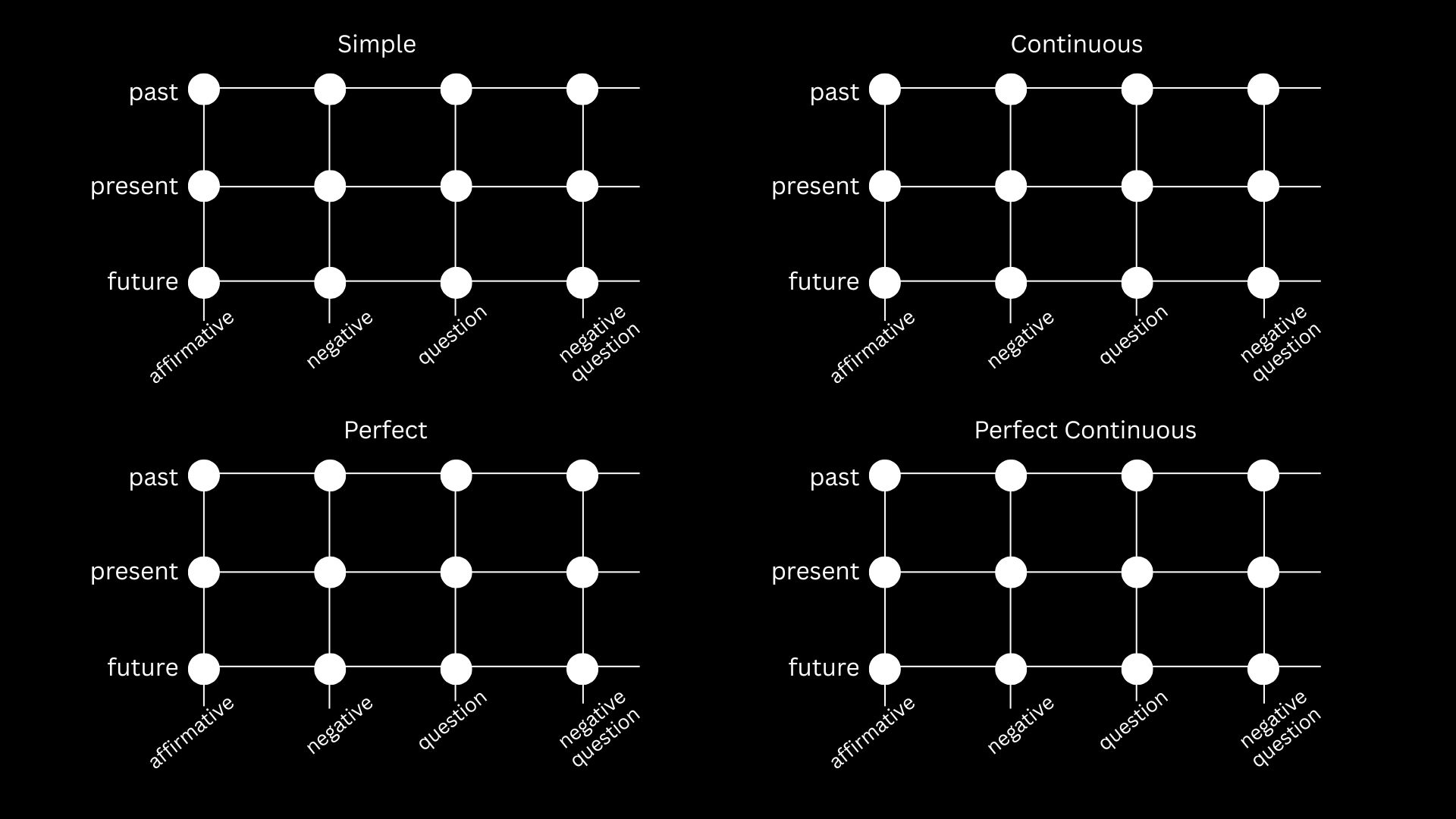Matrix Verb System Dots Explained
Four Tenses
The four groups of dots represent the four sets of tenses.
The tenses are:
- Simple (Top left)
- Continuous (Top right)
- Perfect (Bottom left)
- Perfect Continuous (Bottom right)
Simple
The top left group represent the Simple Tenses.
Continuous
The top right group represent the Continuous Tenses.
Perfect
The bottom left group represent the Perfect Tenses.
Perfect Continuous
The bottom right group represent the Perfect Continuous Tenses.
Three Times
Each group of tenses is divided into three times:
- Past (Top row)
- Present (Middle row)
- Future (Bottom row)
Past
The top row of the top left group represents Past Simple.
Present
The middle row of the top left group represents Present Simple.
Future
The bottom row of the top left group represents Future Simple.
Four Variations
Every tense has four variations:
- Affirmative (Column 1)
- Negative (Column 2)
- Question (Column 3)
- Negative Question (Column 4)
Affirmative
The first column of the top left group represents Simple Affirmative.
Negative
The second column of the top left group represents Simple Negative.
Question
The third column of the top left group represents Simple Question.
Negative Question
The fourth column of the top left group represents Simple Negative Question.
Present Simple Affirmative
The first dot in the present simple row represents Present Simple Affirmative.
- Mike lives in a tree.
Present Simple Negative
The second dot in the present simple row represents Present Simple Negative.
- Mike doesn’t live in a tree.
Present Simple Question
The third dot in the present simple row represents Present Simple Question.
- Does Mike live in a tree?
Present Simple Negative Question
The fourth dot in the present simple row represents Present Simple Negative Question.
- Doesn’t Mike live in a tree?
Past Simple Affirmative
The first dot in the past simple row represents Past Simple Affirmative.
- Mike lived in a tree.
Future Simple Question
The third dot in the future simple row represents Future Simple Question.
- Will Mike live in a tree?
Past Continuous Affirmative
The first dot in the first continuous row represents Past Continuous Affirmative.
- Mike was living in a tree.
Present Continuous Question
The third dot in the present continuous row represents Present Continuous Question.
- Is Mike living in a tree?
Future Continuous Negative
The second dot in the future continuous row represents Future Continuous Negative.
- Mike won’t be living in a tree.
Past Continuous Negative Question
The fourth dot in the past continuous row represents Past Continuous Negative Question.
- Wasn’t Mike living in a tree?
Present Perfect Affirmative
The first dot in the present perfect row represents Present Perfect Affirmative.
- Mike has lived in a tree.
Past Perfect Question
The third dot in the past perfect row represents Past Perfect Question.
- Had Mike lived in a tree?
Future Perfect Negative
The second dot in the future perfect row represents Future Perfect Negative.
- Mike won’t have lived in a tree.
Past Perfect Continuous Affirmative.
The first dot in the past perfect continuous row represents Past Perfect Continuous Affirmative.
- Mike had been living in a tree.
Future Perfect Continuous Negative
The second dot in the future perfect continuous row represents Future Perfect Continuous Negative.
- Mike won’t have been living in a tree.
Present Perfect Continuous Question.
The third dot in the present perfect continuous row represents Present Perfect Continuous Question.
- Has Mike been living in a tree?































